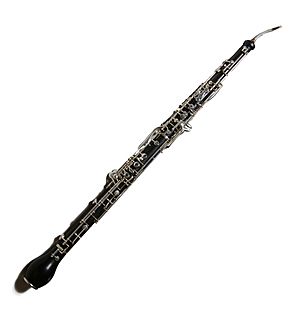Cor anglais facts for kids
The cor anglais, also known as the English horn, is a woodwind instrument. It's part of the double reed family, meaning it uses two pieces of cane that vibrate together to make sound. It looks a lot like an oboe, but it's longer. Because it's longer, it plays lower notes.
The lowest note an oboe can play is a B flat. The cor anglais can play an E natural, which is quite a bit lower. It's like a deeper voice compared to the oboe.
The cor anglais is a transposing instrument. This means that when a musician reads a note, the sound that comes out is actually lower than what's written. For the cor anglais, the music sounds five notes lower than what the player sees on the page. This helps players who also play the oboe, as they can use similar fingering patterns.
The bottom part of the instrument, called the bell, looks like a pear. This special shape helps give the cor anglais its warm, less "nasal" sound. Unlike an oboe's reed, the cor anglais reed connects directly to a small metal tube called a "bocal" at the top of the instrument.
Why "English Horn"?
The name "cor anglais" comes from French and literally means "English horn." But here's a fun fact: the cor anglais is not from England, and it's not a horn! No one is completely sure how it got its name. One idea is that the curved metal tube (the bocal) at the top might have looked "angled" or "bent." The French word for "angled" (anglé) sounds a lot like the word for "English" (anglais).
Where You Hear It
Many musicians who play the oboe can also play the cor anglais. This is common for musicians who "double" on similar instruments, like flautists who also play the piccolo.
You won't find many solo pieces written just for the cor anglais. Instead, it's often used in orchestras for beautiful, slow melodies. Its rich, expressive sound makes it perfect for emotional parts of music.
Here are some famous pieces where you can hear the cor anglais:
- Alfred Reed's Russian Christmas Music (from 1944)
- Antonín Dvořák's Symphony No. 9, also known as the New World Symphony (especially in the slow second movement, called Largo)
- Joaquín Rodrigo's Concierto de Aranjuez (in the second movement, from 1939)
- Hector Berlioz's Symphonie fantastique (in the third movement, from 1830)
- Alexander Borodin's Eine Steppenskizze aus Mittelasien
Images for kids
-
Opening motive from the 2nd movement (Largo) of Dvořák's Symphony No. 9, From the New World
See also
 In Spanish: Corno inglés para niños
In Spanish: Corno inglés para niños


